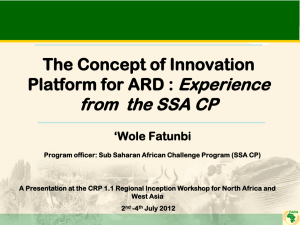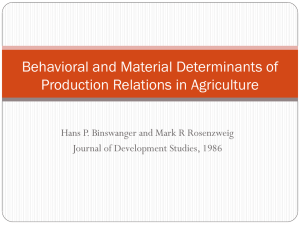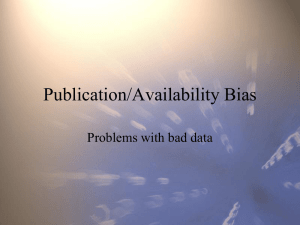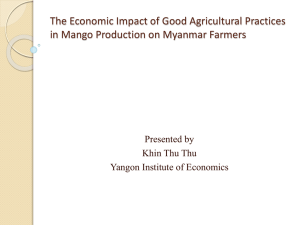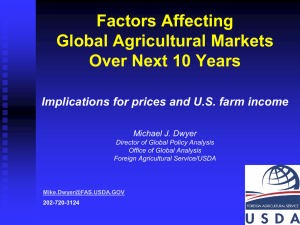Standard Bank - CIB Pitch Book - PPT 2007
advertisement
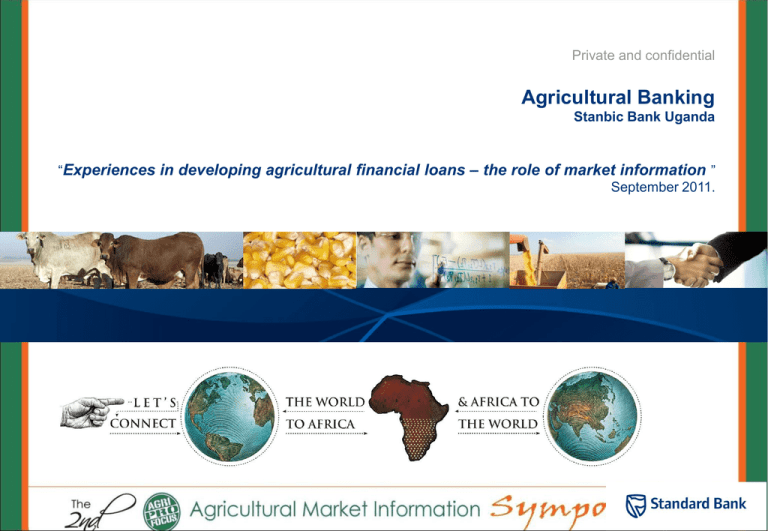
Private and confidential Agricultural Banking Stanbic Bank Uganda “Experiences in developing agricultural financial loans – the role of market information ” September 2011. Outline 1. Overview of Stanbic Bank (U) Ltd 2. Changing agriculture sector landscape and the improving market information : creates opportunity for Africa 3. Standard Bank Agricultural Banking 4. The smallholder farmers and Agribusiness funding scheme 5. Success Factors and Key constraints 6. Key message 1 Private and confidential Section 1 Overview of Stanbic Bank Stanbic Bank : African Roots with Global Reach •Stanbic Bank (U) Ltd– largest branch network • 97 branches; over 60%upcountry •Extensive expertise and strong track record of operating in emerging markets, mainly in Africa. • The largest African bank by geographic spread, assets, earnings and market capitalization • Winner of the Development Finance Initiative of the year. Agribusiness Investment Award 2010. Africa Investor Background African Footprint Key regional offices •Established in 1862 • 17 African countries • Over 1,000 Branches & 7,500 ATMs across these geographic regions • Offices in key regional financial centre's including London, Moscow, New York, Hong Kong, Sao Paulo and Dubai •Listed on the JSE •Largest trader of African currencies in the world 3 4 Out Africa footprint Country South Africa Botswana* Libya Egypt Swaziland Namibia Eritrea Niger Chad Sudan Zimbabwe* Djibouti Somalia Nigeria Ethiopia Central African Zambia* Republic Cameroon Malawi UgandaKenya Gabon Congo Democratic Mozambique Republic of Rwanda Congo (DRC) Burundi Ghana* Tanzania Seychelles Nigeria* Angola Zambia Kenya* Madagascar Zimbabwe Namibia Lesotho Mozambique Mauritius Botswana Uganda* Swaziland DRC* Lesotho South Africa Angola* Tanzania* Mauritius Tunisia Morocco Algeria Western Sahara Mauritania Cape Verde Mali Senegal Gambia Guinea Guinea Bissau Sierra Leone Burkina Faso Benin Togo Ivory Coast Ghana Liberia Equatorial Guinea Malawi * Trading as Stanbic Bank 4 Branches Corporate Banking Retail Banking 664 10 11 44 18 12 19 34 21 96 16 15 98 2 1 11 1 ✔ ✔ ✔ ✔ ✔ ✔ ✔ ✔ ✔ ✔ ✔ ✔ ✔ ✔ ✔ ✔ ✔ ✔ ✔ ✔ ✔ ✔ ✔ ✔ ✔ ✔ ✔ ✔ ✔ ✔ ✔ * ✔ ✔ Private and confidential Section 2: Changing landscape in the agriculture sector: creates opportunity for Africa 6 The role of Market information in banking product development and offering Market Information Plays a leading role in the Banks product development and offering; –Prices of agricultural Commodities at Key points in the value chain –Reliable Historical data gives an indication of future price movements and demand –Data on movement of prices and demand in agricultural commodities forms a strong basis in product development and offering Changing landscape in the global agriculture sector Some key trends Global consumption of food & livestock to increase significantly by 2019 (by about 50% for developing countries) Food prices increases (mainly due to increase in energy price) Global food inflation increased sharply from 2007-10 (mainly for low and low-middleincome countries) Africa realizing significant annual growth: > 5% GDP growth Agricultural yields stagnated in spite of average per capita production increase Opportunities Africa has the potential to increase production and productivity to meet growing demand food demand Establish Agric functional and more lucrative supply chains commodity export opportunities for Africa Import substitution that will arise from increasingly competitive African agribusinesses. 7 Private and confidential Section 3 Agricultural Banking – Integrated value chain finance approach and product offering Banking the Agricultural Value Chain: Needs and Products Value Chain Input and Logistics Suppliers Farmers (small and commercial) Commodity Traders Primary Processors Food & Beverage Companies Finance instruments Risk* and Other Products Repurchase Agreements Warehouse financing Project finance Vehicle and Asset Finance (VAF) Physical brokering Price hedges (fertiliser, fuel?) Currency and ex rate hedges, FX Research Need timely production finance for inputs to ensure yields MTL to expand the businesses Price hedges to mitigate price volatility risk Crop insurance to mitigate risks Input Finance Crop Advance (prepayment for crop) VAF Physical brokering Commodity price hedges, for own benefit and to facilitate financing Crop and weather Insurance Need finance to purchase crops (quality and quantity) at optimum time Need risk mitigation instruments for margin payments and support for carry trades Need finance for expansion and a acquisition targets Commodity finance – Repurchase Agreements – Receivables Finance – Warehouse receipt finance Leverage and acquisition finance Physical brokering Commodity price hedges Currency and ex rate hedges, FX Research To secure control over raw material Liquidity to buy at optimal time Hedging of revenues where processed commodity tradeable Need finance for expansion and acquisition targets Commodity finance – Repurchase Agreements Receivables finance Leverage and acquisition finance Physical brokering Commodity price hedges Currency and ex rate hedges, FX M&A Advisory Research Need liquidity to buy at optimal time, but want to reduce w. capital and credit risk Need finance expansion and acquisition targets Commodity finance Leverage and acquisition finance VAF [Physical brokering] Commodity price hedges Currency and ex rate hedges, FX M&A Advisory Research Activities & Needs Fert and seed co’s aim to increase penetration by facilitating input finance Need to manage raw materials cost, and price volatility for buyers Capex for plant , equipment and infra Wholesales and Retailers * Note, derivatives still restricted to SA (Safex) and some African imports and exports 10 Current product offering Stanbic Bank in partnership with AGRA and Kilimo Trust set up the Agri-Business Loan Scheme (Small holder Financing) The Government Agric Facility Vehicle Ware and Asset Financing house receipt financing Danida aBi Guarantee Commercial Agriculture “Flexible and Innovative Agric Financing” Overview of the Agribusiness Scheme The scheme is a three year program and will disburse up to $100 million targeting 750,000 smallholder farmers and agribusinesses in 4 African countries: Uganda, Tanzania, Mozambique and Ghana partners provide partial risk cover (1st loss guarantee and 50% risk participation) Risk The scheme relies on value chain finance to leverage on the interlocking arrangements among the value chain actors The scheme leverage on partnerships to take the advantage of mechanization, TA support and precision agriculture to improve production efficiencies The scheme financial instruments include: – Input finance and agricultural production loans, – Commodity finance, – Agricultural machinery/equipment finance 11 Our partners are: • KILIMO Trust, • The Alliance for a Green Revolution in Africa (AGRA) •OPEC Fund for International Development (OFID) • Risk participation: • 1st loss guarantee and • 50%/50% risk sharing 12 The Small holder farmer funding model: Risk sharing Partners Contract and monitor TA providers Bank RSG Off-taker Technical Assistance Provider Agric input / equipment providers Off-taking agreement Co-ops Smallholder Farmers 14 Aggregate portfolio performance • Financed more than 70 projects • Total number of smallholder farmers benefiting from the scheme is about 5,000 15 Country Specific financing •Agricultural Production Crops •Agricultural production Livestock &poultry •Marketing including commodity trade •Processing and light industries Private and confidential Section 5 Success factors and key constraints Some success factors • Specialized Agricultural Banking: products and expertise • Structured finance approach: • Structured finance approach • Self-liquidating and cash flow based finance • Leverage on partnerships: lead firms, NGOs, etc • Legally binding contracts. e.g. tripartite agreements, TA provision agreement and joint liability guarantee • Increasing production efficiencies: • Agronomy services and crop husbandry • GIS mapping and soil testing • Agricultural production manual & guidelines • Mechanization: partnership with John Deere for the provision of agricultural equipment. • Upgrading the value chains. Example, enabling farmers access to market through partnership with WFP and large domestic, regional and international agribusiness Cross selling opportunity: 55,000 smallholder farmers accessing finance through this scheme. How to bank them? 17 Some key constraints • Maximizing the value chain finance concept in a context where: • Inexistent/ underdeveloped value chains (mainly food crops) • Loans are generally high volumes but relative small values • Weak CBOs (producer groups, associations and co-operatives) • Climate change: heavy reliance on rain fed agriculture • Unorganised supply and demand • High post harvest losses • Erratic production due to weather shocks and seasonality • High transaction costs resulting from information asymmetry and poor information flow. (adverse selection and moral hazard) • Weak systems for contract enforcement (legally binding contracts) • Lack of legislation and/or regulations suitable to agriculture financial intermediation (e.g. commodity finance supporting instruments) 18 MIS requirements for appropriate Agric-financing Agricultural produce pricing –Farm gate prices –Wholesale prices –Export / main off taker prices Quantities Price and Quality and quantity movements over time Expected costs involved Seasonality Storage of crops and regional differences and processing capacities availability and location Availability Ease of markets and major market players of delivery to markets 19 Private and confidential Section 5 Key message Key messages for conducive policy • • • • • Addressing market failures: information asymmetry • Appropriate policies and regulations • Avoid market distorting policies. e.g. government funding schemes, marketing and price control, etc • Strengthen CBOs (producer groups, associations and co-operatives) to enable access to farmers • Build climate change resilience and adaptation: e.g. investment in small and medium scale irrigation systems, Investing in public goods and infrastructures Adopting policies and strategies to re-risk agriculture sector: e.g. risk sharing and price hedging Harnessing legal systems for contract enforcement Harnessing legislation and/or regulations suitable to agriculture financial intermediation (e.g. commodity finance supporting instruments) 21 Contact Details Richard Wangwe Head, Agriculture Stanbic Bank (U) Ltd, 0417154210 wangwer@stanbic.com Thank you
